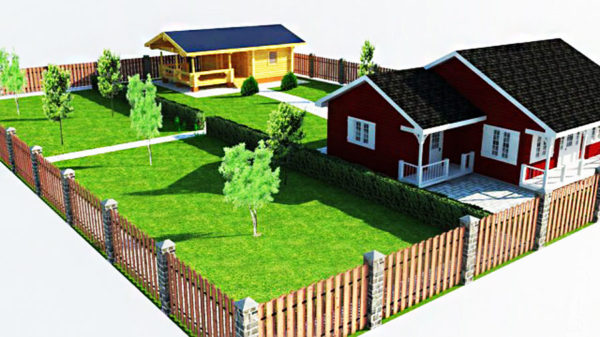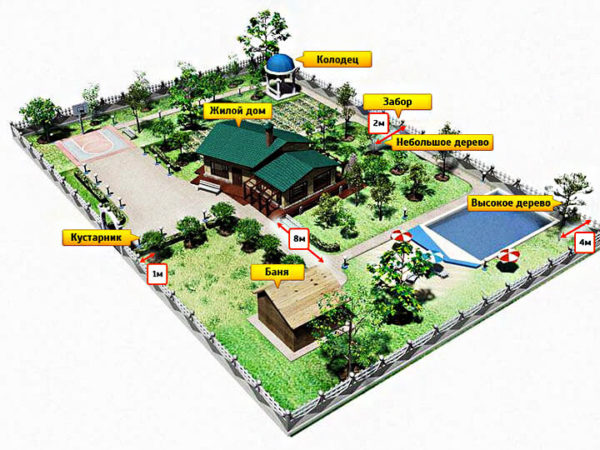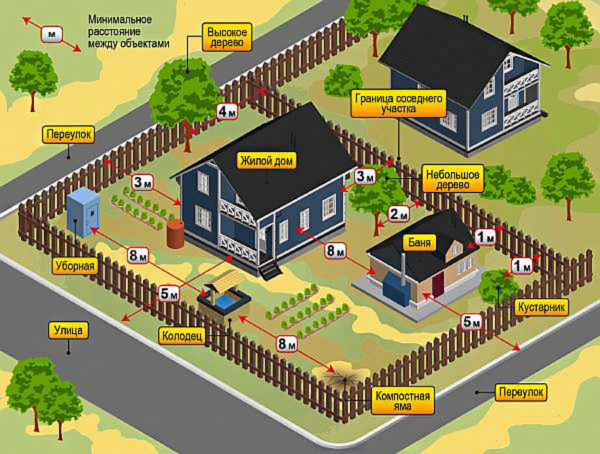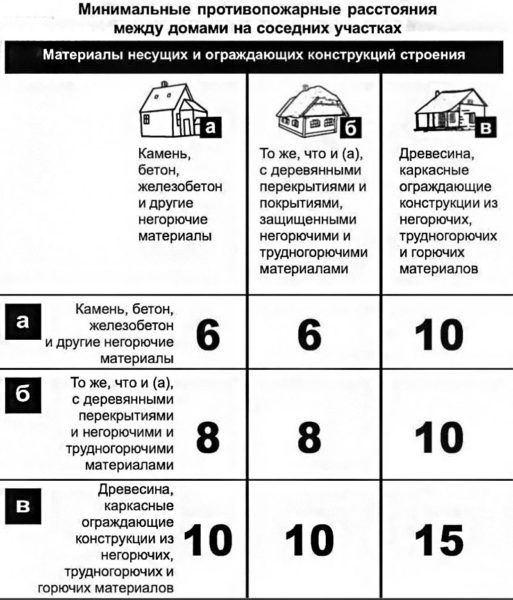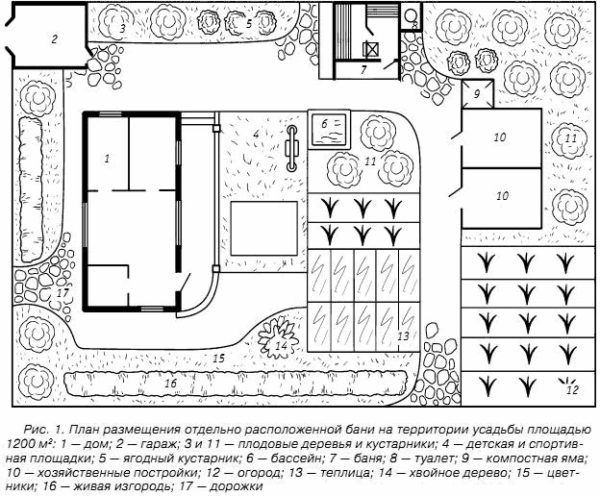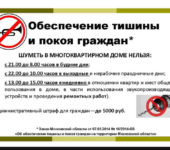The distance from the bathhouse to other buildings on the site according to SNiP
According to the requirements of SNiP and SP, a bathhouse on the IZHS or SNT site should be located at a certain distance both from the fence and from residential and utility buildings, water supply sources and other facilities.
If the bathhouse is too close to a house, a well, a neighbor's plot or a fence, its construction may be considered illegal and oblige the owner to remove the building. To avoid the problem, you should take into account the requirements of building and fire safety codes even at the stage of creating a project, especially if you develop it yourself.
The content of the article
The location of the bath on the site, taking into account the norms of SNiP
The norms for the placement of this building are regulated by SNiP 30-02-97 and SP 53.13330.2011, as well as SP 11-106-97. The minimum distance from the sauna varies depending on the type of the second object and the building materials used. Taking into account SNiP and SP, the following requirements apply:
- The distance from the bathhouse to the fence should be at least 1 meter, measured from the boundary. This indicator is relevant if the fence is made of metal or other non-combustible materials. If the fence is wooden, the minimum indentation is 3 meters. The latter indicator is also indicated in the requirements of the joint venture: it is due to the fact that such a distance will provide complete protection of the neighboring territory from wastewater. There is also an exception: if the sauna project provides for connection to the sewer system, proper arrangement of drainage, then the offset of the bath from the neighbor's fence can be 1 meter.
- There must be at least 5 meters between the sauna and the street road that runs behind the fence of the territory where the building is located.
- The distance to utility and other non-residential buildings is from 6 to 15 m, depending on what materials were used for their construction.
- Gardens, plantations and other clusters of trees and bushes are 15 meters away.
- The distance from the house to the bathhouse is at least 8 meters.
- There must be at least 5 m from the sauna to water bodies, which include rivers, ponds, lakes, channels, etc.
- If there are tall trees on the site, they should be 4 m and further from such a building. For medium-sized plants, the distance will be 3 m, and for bushes - 1 meter.
Please note that local regulations may differ, and before proceeding with the construction of a sauna, you should clarify if there are more stringent restrictions in the selected region.
Construction standards taking into account materials
When creating a project and determining the location of the future building on the site, it is important to pay attention to the materials for the manufacture of the bath itself and the buildings surrounding it. Primary requirements:
- There must be at least 6 meters between buildings made of stone, block, reinforced concrete products, as well as buildings built using monolithic technology.
- The distance between the house and the bathhouse, if the first one was built according to the technologies described above, but has wooden floors, is already 8 meters.
- Between wooden buildings - 15 m. This requirement applies both for buildings located on the same site and in different territories. In other words, the distance from the bathhouse to the bathhouse of a neighbor, if both objects are wooden, should be at least 15 m.
- A stone fence from a bath with wooden floors is 6 meters away.
- There should be at least 6 meters between the fence on the wood frame and the stone sauna.
- If the fence is made of wood in whole or in part, and there are wooden floors in the bath, a distance of 8 m must be maintained between these objects.
- There should be at least 10 m between the wooden fence and the wooden sauna. The same requirement is relevant if the sauna is made of stone and has floors of flammable materials.
Distance to the bathhouse according to fire regulations
Fire safety standards classify baths and saunas to class F3.6, this is confirmed in the text of SNiP 01.21.97. According to the PB requirements, the distance from such an object to a residential building should be as follows:
- If both buildings are made of brick or stone, and their roofs are made of non-combustible materials - 8 meters.
- If the house or bath has a roof made of flammable materials - 10 meters.
- If the objects are built of wood or other materials that quickly light up - 10 m.
- For buildings above 1 floor, the distance increases to 15 meters.
The distance from the border is 1 meter if the project provides for sewerage and drainage, and 3 m when the arrangement of these communications is not planned. The distance from the bathhouse in the neighboring area is 6 meters for brick structures and up to 15 if both buildings are wooden. If local restrictions apply, the distance may be greater, this point should be clarified in advance with the administration of the district to which the IZhS site belongs, or with the chairman of SNT.
Coordination of the project of a bath in the garden
Any building that is built on a site in a summer cottage or garden non-profit partnership and has a foundation does not belong to commercial buildings, and its project must be approved. The bathhouse is no exception to this rule. If we neglect the design and approval of the project, the object will be classified as self-built, it will not be possible to enter it into the real estate cadastre. To obtain permission, you need to collect the following set of papers:
- Statement. Submitted on the website of Rosreestr, State Service or when visiting the MFC.
- A document identifying the identity of the owner of the site.
- Papers confirming the ownership of the territory.
- Topographic plan, where all the distances from the bathhouse to the residential building, fence, well, barn, neighbor's house and other objects are indicated. This document must be linked to the general plan of the settlement.
- Cadastral plan of the land plot with size designation.
- Real estate appraisal paper received at the BTI.
- A plan for the location of utilities with marks of points of connection to municipal communications, if any.
- Blueprint for a new building on the territory.
If a company specializing in such services is engaged in the design, the owner does not have to deal with the preparation and provision of documents: all this is done by hired employees. The project itself must contain the following information:
- Description of the future building with its purpose.
- Exact perimeter measurements, interior layout.
- Steam room, heating equipment type.
- Materials used for construction and decoration, their quantity.
- Methods for supplying clean water and draining wastewater.
- Ventilation system, its type (natural or forced), power calculation.
- Removing the bath on the site from the borders and other objects on the owner's site and neighboring territory.
Conclusion
The distance from the bathhouse to residential and non-residential buildings, water supply sources, site boundaries and other objects must comply with the requirements of SanPin and SNiP. This indicator depends on the characteristics of specific objects, construction materials, number of storeys of buildings and the type of engineering systems. Regional requirements may tighten regulations. It is recommended to think over these nuances in advance and create a project taking into account the current legislation.In order not to face a refusal to approve the project, you can entrust the task to experienced specialists who know the intricacies of modern legislation and its latest changes.

